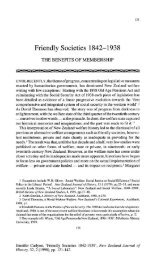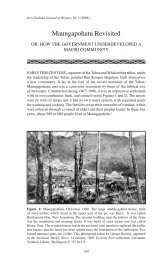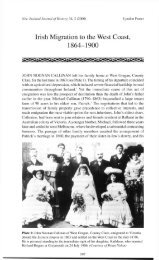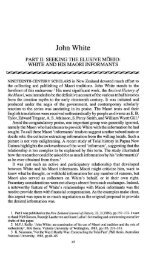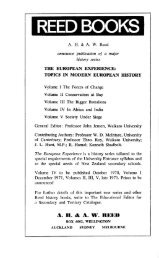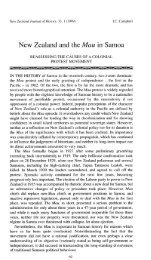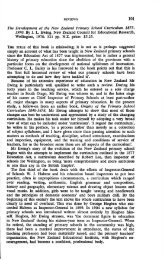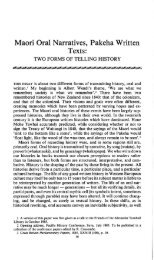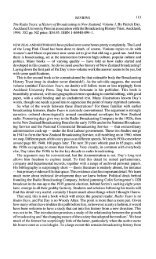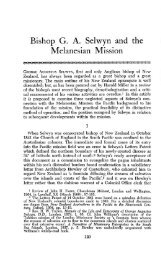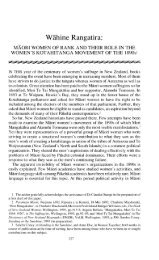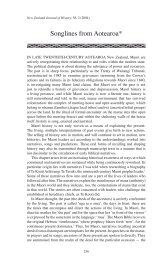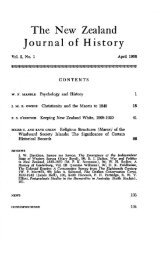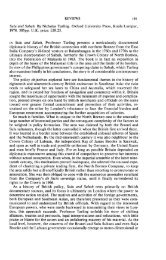Women in History: Essays on European Women in New Zealand ...
Women in History: Essays on European Women in New Zealand ...
Women in History: Essays on European Women in New Zealand ...
Create successful ePaper yourself
Turn your PDF publications into a flip-book with our unique Google optimized e-Paper software.
REVIEWS 91<br />
<str<strong>on</strong>g>Women</str<strong>on</strong>g> <str<strong>on</strong>g>in</str<strong>on</strong>g> <str<strong>on</strong>g>History</str<strong>on</strong>g>: <str<strong>on</strong>g>Essays</str<strong>on</strong>g> <strong>on</strong> <strong>European</strong> <str<strong>on</strong>g>Women</str<strong>on</strong>g> <str<strong>on</strong>g>in</str<strong>on</strong>g> <strong>New</strong> <strong>Zealand</strong>. Edited by Barbara<br />
Brookes, Charlotte Macd<strong>on</strong>ald, and Margaret Tennant. Allen & Unw<str<strong>on</strong>g>in</str<strong>on</strong>g>/Port Nichols<strong>on</strong><br />
Press, Well<str<strong>on</strong>g>in</str<strong>on</strong>g>gt<strong>on</strong>, 1986. 202pp., illus. NZ price: $24.95 paperback.<br />
WOMEN IN HISTORY is a collecti<strong>on</strong> of ten essays deal<str<strong>on</strong>g>in</str<strong>on</strong>g>g specifically with Pakeha women<br />
<str<strong>on</strong>g>in</str<strong>on</strong>g> the period 1860-1939. Although the editors acknowledge that the collecti<strong>on</strong> possesses<br />
'gaps and silences', they have, nevertheless, to use Dale Spender's words, documented<br />
some very important absences <str<strong>on</strong>g>in</str<strong>on</strong>g> our knowledge of women's history. Issues such as<br />
sexuality, fertility, childbirth, welfare, and nati<strong>on</strong>ality are dealt with <str<strong>on</strong>g>in</str<strong>on</strong>g> <str<strong>on</strong>g>in</str<strong>on</strong>g>dividual essays.<br />
However, the subtitle of this collecti<strong>on</strong> absolves the editors <strong>on</strong>ly <str<strong>on</strong>g>in</str<strong>on</strong>g> part from their<br />
obligati<strong>on</strong> to be more comprehensive <str<strong>on</strong>g>in</str<strong>on</strong>g> their selecti<strong>on</strong> of essays, particularly as the<br />
book's ma<str<strong>on</strong>g>in</str<strong>on</strong>g> title suggests an all-embrac<str<strong>on</strong>g>in</str<strong>on</strong>g>g treatment of women <str<strong>on</strong>g>in</str<strong>on</strong>g> the past. Their aim is<br />
'to encourage new ways of see<str<strong>on</strong>g>in</str<strong>on</strong>g>g the past so that a history without reference to gender<br />
will be unth<str<strong>on</strong>g>in</str<strong>on</strong>g>kable.' It is to be hoped that a history without reference to race and gender<br />
would also be unth<str<strong>on</strong>g>in</str<strong>on</strong>g>kable. Although it is not the editors' <str<strong>on</strong>g>in</str<strong>on</strong>g>tenti<strong>on</strong> to make certa<str<strong>on</strong>g>in</str<strong>on</strong>g> groups<br />
of women <str<strong>on</strong>g>in</str<strong>on</strong>g>visible, especially Maori women, there is still an <strong>on</strong>us <strong>on</strong> the editors to justify<br />
more fully their decisi<strong>on</strong> to focus <strong>on</strong> <strong>European</strong> women <str<strong>on</strong>g>in</str<strong>on</strong>g> this period.<br />
The publicati<strong>on</strong> of <str<strong>on</strong>g>Women</str<strong>on</strong>g> <str<strong>on</strong>g>in</str<strong>on</strong>g> <str<strong>on</strong>g>History</str<strong>on</strong>g> <str<strong>on</strong>g>in</str<strong>on</strong>g> paperback form certa<str<strong>on</strong>g>in</str<strong>on</strong>g>ly helps the editors <str<strong>on</strong>g>in</str<strong>on</strong>g><br />
their aim to make some of the recent scholarly work <strong>on</strong> women's history more widely<br />
available. The collecti<strong>on</strong> <str<strong>on</strong>g>in</str<strong>on</strong>g>cludes c<strong>on</strong>ference papers and articles which have appeared <str<strong>on</strong>g>in</str<strong>on</strong>g><br />
academic journals (three of them <str<strong>on</strong>g>in</str<strong>on</strong>g> this journal) s<str<strong>on</strong>g>in</str<strong>on</strong>g>ce 1975. Most of the essays, however,<br />
have been written s<str<strong>on</strong>g>in</str<strong>on</strong>g>ce 1980, which is a reflecti<strong>on</strong>, not <strong>on</strong>ly of the <str<strong>on</strong>g>in</str<strong>on</strong>g>crease <str<strong>on</strong>g>in</str<strong>on</strong>g><br />
appo<str<strong>on</strong>g>in</str<strong>on</strong>g>tments of women to academic positi<strong>on</strong>s, but also of the c<strong>on</strong>t<str<strong>on</strong>g>in</str<strong>on</strong>g>ued growth of<br />
<str<strong>on</strong>g>in</str<strong>on</strong>g>terest <str<strong>on</strong>g>in</str<strong>on</strong>g> women's history. Nevertheless, the study of women <str<strong>on</strong>g>in</str<strong>on</strong>g> <strong>New</strong> <strong>Zealand</strong>'s history<br />
is <str<strong>on</strong>g>in</str<strong>on</strong>g> its <str<strong>on</strong>g>in</str<strong>on</strong>g>fancy, as is illustrated by the editors' guide to further read<str<strong>on</strong>g>in</str<strong>on</strong>g>g: articles and papers<br />
listed outnumber books by two to <strong>on</strong>e. Of the theses produced <str<strong>on</strong>g>in</str<strong>on</strong>g> <strong>New</strong> <strong>Zealand</strong><br />
universities, <strong>on</strong>ly three are doctoral dissertati<strong>on</strong>s. That is why collecti<strong>on</strong>s of this k<str<strong>on</strong>g>in</str<strong>on</strong>g>d are<br />
important: they encourage future research, and provide valuable teach<str<strong>on</strong>g>in</str<strong>on</strong>g>g materials that<br />
enable historians to <str<strong>on</strong>g>in</str<strong>on</strong>g>clude women's history as part of their ma<str<strong>on</strong>g>in</str<strong>on</strong>g>stream teach<str<strong>on</strong>g>in</str<strong>on</strong>g>g.<br />
The essays written especially for this volume <str<strong>on</strong>g>in</str<strong>on</strong>g>clude Philippa Me<str<strong>on</strong>g>in</str<strong>on</strong>g> Smith's 'Mortality<br />
<str<strong>on</strong>g>in</str<strong>on</strong>g> Childbirth <str<strong>on</strong>g>in</str<strong>on</strong>g> the 1920s and 1930s', Ruth Fry's '"D<strong>on</strong>'t Let Down the Side":<br />
Physical Educati<strong>on</strong> <str<strong>on</strong>g>in</str<strong>on</strong>g> the Curriculum for <strong>New</strong> <strong>Zealand</strong> Schoolgirls 1900-1945', and<br />
Dorothy Page's '<str<strong>on</strong>g>Women</str<strong>on</strong>g> and Nati<strong>on</strong>ality: Fem<str<strong>on</strong>g>in</str<strong>on</strong>g>ist Organisati<strong>on</strong>s <str<strong>on</strong>g>in</str<strong>on</strong>g> the Inter-War<br />
Period'. Philippa Me<str<strong>on</strong>g>in</str<strong>on</strong>g> Smith and Ruth Fry have provided fasc<str<strong>on</strong>g>in</str<strong>on</strong>g>at<str<strong>on</strong>g>in</str<strong>on</strong>g>g <str<strong>on</strong>g>in</str<strong>on</strong>g>sights <str<strong>on</strong>g>in</str<strong>on</strong>g>to two<br />
key areas of women's lives: childbirth and educati<strong>on</strong>. The essays <strong>on</strong> these and other topics<br />
complement and, to a large extent, relate to an already substantial Anglo-American<br />
historiography. The orientati<strong>on</strong> of Dorothy Page's essay is slightly different <str<strong>on</strong>g>in</str<strong>on</strong>g> that it<br />
offers an <str<strong>on</strong>g>in</str<strong>on</strong>g>sight <str<strong>on</strong>g>in</str<strong>on</strong>g>to an issue for which there is a less substantial body of sec<strong>on</strong>dary<br />
literature. Her research shows how a married woman's nati<strong>on</strong>ality became a political<br />
issue for women <str<strong>on</strong>g>in</str<strong>on</strong>g> <strong>New</strong> <strong>Zealand</strong> after the First World War, especially as the 1914 British<br />
Nati<strong>on</strong>ality and Status of Aliens Act disenfranchised the British-born wives of aliens <str<strong>on</strong>g>in</str<strong>on</strong>g><br />
<strong>New</strong> <strong>Zealand</strong>, and required them to register with the police. The issue became a matter<br />
of c<strong>on</strong>cern for women <str<strong>on</strong>g>in</str<strong>on</strong>g> Brita<str<strong>on</strong>g>in</str<strong>on</strong>g> and the Comm<strong>on</strong>wealth, and Dorothy Page has shown<br />
how women's organizati<strong>on</strong>s <str<strong>on</strong>g>in</str<strong>on</strong>g> <strong>New</strong> <strong>Zealand</strong> co-operated with British fem<str<strong>on</strong>g>in</str<strong>on</strong>g>ists <str<strong>on</strong>g>in</str<strong>on</strong>g><br />
lobby<str<strong>on</strong>g>in</str<strong>on</strong>g>g for redress under <str<strong>on</strong>g>in</str<strong>on</strong>g>ternati<strong>on</strong>al law.<br />
A major advantage of this collecti<strong>on</strong> of essays is their focus up<strong>on</strong> a limited time span<br />
— a po<str<strong>on</strong>g>in</str<strong>on</strong>g>t missed by the choice of title and underplayed <str<strong>on</strong>g>in</str<strong>on</strong>g> the <str<strong>on</strong>g>in</str<strong>on</strong>g>troducti<strong>on</strong>. The essays<br />
complement each other extremely well, and offer a well-rounded picture of Pakeha
92 REVIEWS<br />
women. As it stands, the collecti<strong>on</strong> provides a very useful <str<strong>on</strong>g>in</str<strong>on</strong>g>troducti<strong>on</strong> to the lives of<br />
<strong>European</strong> women <str<strong>on</strong>g>in</str<strong>on</strong>g> this 80-year period and is a very worthwhile publicati<strong>on</strong> to add to our<br />
small, but grow<str<strong>on</strong>g>in</str<strong>on</strong>g>g, number of books <strong>on</strong> <strong>New</strong> <strong>Zealand</strong> women.<br />
MAUREEN MONTGOMERY<br />
University of Canterbury<br />
<str<strong>on</strong>g>Women</str<strong>on</strong>g>'s Suffrage <str<strong>on</strong>g>in</str<strong>on</strong>g> <strong>New</strong> <strong>Zealand</strong>. By Patricia Grimshaw. Auckland University Press/<br />
Oxford University Press, Auckland, 1987 repr<str<strong>on</strong>g>in</str<strong>on</strong>g>t. 156pp., NZ price: $27.95.<br />
<str<strong>on</strong>g>Women</str<strong>on</strong>g> and the Vote. Edited by R. P. Hargreaves and T. J. Hearn. Victorian <strong>New</strong> <strong>Zealand</strong><br />
Repr<str<strong>on</strong>g>in</str<strong>on</strong>g>t Series No. 7, Hocken Library, Duned<str<strong>on</strong>g>in</str<strong>on</strong>g>, 1986. 39pp. NZ price: $5.50.<br />
FOR MANY students of <strong>New</strong> <strong>Zealand</strong> history (myself <str<strong>on</strong>g>in</str<strong>on</strong>g>cluded), the 1972 publicati<strong>on</strong> of<br />
Patricia Grimshaw's <str<strong>on</strong>g>Women</str<strong>on</strong>g>'s Suffrage <str<strong>on</strong>g>in</str<strong>on</strong>g> <strong>New</strong> <strong>Zealand</strong> provided a first acqua<str<strong>on</strong>g>in</str<strong>on</strong>g>tance<br />
with women's history. It <str<strong>on</strong>g>in</str<strong>on</strong>g>troduced us to an aspect of Pakeha women's experience that<br />
went bey<strong>on</strong>d the <strong>on</strong>e-dimensi<strong>on</strong>al image of the 'pi<strong>on</strong>eer woman', stoically bak<str<strong>on</strong>g>in</str<strong>on</strong>g>g and<br />
breed<str<strong>on</strong>g>in</str<strong>on</strong>g>g <str<strong>on</strong>g>in</str<strong>on</strong>g> the backblocks, while her man carved a farm out of the bush. It challenged the<br />
Reevesian noti<strong>on</strong> that <strong>New</strong> <strong>Zealand</strong> women suddenly woke <strong>on</strong>e morn<str<strong>on</strong>g>in</str<strong>on</strong>g>g <str<strong>on</strong>g>in</str<strong>on</strong>g> 1893 to f<str<strong>on</strong>g>in</str<strong>on</strong>g>d<br />
themselves enfranchised — courtesy of male legislators. In show<str<strong>on</strong>g>in</str<strong>on</strong>g>g that a group of<br />
women activists, the majority of them associated with the WCTU, fought a l<strong>on</strong>g, energetic<br />
campaign for the vote, Grimshaw provided a model of scholarship for subsequent thesis<br />
writers and researchers. She raised questi<strong>on</strong>s about the motivati<strong>on</strong>s of these so-called<br />
'first-wave' fem<str<strong>on</strong>g>in</str<strong>on</strong>g>ists and the subsequent fate of the women's movement <str<strong>on</strong>g>in</str<strong>on</strong>g> <strong>New</strong> <strong>Zealand</strong>.<br />
In the fifteen years between the firstpublicati<strong>on</strong> of <str<strong>on</strong>g>Women</str<strong>on</strong>g>'s Suffrage <str<strong>on</strong>g>in</str<strong>on</strong>g> <strong>New</strong> <strong>Zealand</strong><br />
and this paperback repr<str<strong>on</strong>g>in</str<strong>on</strong>g>t, there has been little to supersede Grimshaw's research. While<br />
Grimshaw's focus was more often women's entry <str<strong>on</strong>g>in</str<strong>on</strong>g>to new spheres of activity, and that<br />
strand of liberal fem<str<strong>on</strong>g>in</str<strong>on</strong>g>ism which emphasized equality between the sexes, later work by<br />
Raewyn Dalziel placed greater emphasis <strong>on</strong> sexual difference as the basis of women's<br />
claims to public <str<strong>on</strong>g>in</str<strong>on</strong>g>fluence. In a 1980 essay, Phillida Bunkle po<str<strong>on</strong>g>in</str<strong>on</strong>g>ted out the very<br />
ambivalent nature of the WCTU's fem<str<strong>on</strong>g>in</str<strong>on</strong>g>ism, especially as it was directed to issues such<br />
as social purity. Other extensi<strong>on</strong>s of Grimshaw's work have been restricted to postgraduate<br />
theses, most notably Shelly Griffith's Otago dissertati<strong>on</strong>, 'Fem<str<strong>on</strong>g>in</str<strong>on</strong>g>ism and the<br />
Ideology of Motherhood <str<strong>on</strong>g>in</str<strong>on</strong>g> <strong>New</strong> <strong>Zealand</strong>', which took the study of early <strong>New</strong> <strong>Zealand</strong><br />
fem<str<strong>on</strong>g>in</str<strong>on</strong>g>ism bey<strong>on</strong>d the suffrage campaign and bey<strong>on</strong>d the 1890s.<br />
In an <str<strong>on</strong>g>in</str<strong>on</strong>g>terest<str<strong>on</strong>g>in</str<strong>on</strong>g>g 'Afterword' to the repr<str<strong>on</strong>g>in</str<strong>on</strong>g>t, Grimshaw reflects up<strong>on</strong> her earlier<br />
f<str<strong>on</strong>g>in</str<strong>on</strong>g>d<str<strong>on</strong>g>in</str<strong>on</strong>g>gs <str<strong>on</strong>g>in</str<strong>on</strong>g> the light of this more recent research, and the further c<strong>on</strong>ceptualizati<strong>on</strong> of<br />
women's history over the 1970s and 1980s. She gives greater weight than before to the<br />
c<strong>on</strong>tradicti<strong>on</strong>s <str<strong>on</strong>g>in</str<strong>on</strong>g> n<str<strong>on</strong>g>in</str<strong>on</strong>g>eteenth-century fem<str<strong>on</strong>g>in</str<strong>on</strong>g>ism, but suggests that even arguments based<br />
up<strong>on</strong> maternal <str<strong>on</strong>g>in</str<strong>on</strong>g>fluence and sexual difference had radical potential, and were used to<br />
challenge traditi<strong>on</strong>al c<strong>on</strong>cepts of women's place. Grimshaw acknowledges that <str<strong>on</strong>g>Women</str<strong>on</strong>g>'s<br />
Suffrage <str<strong>on</strong>g>in</str<strong>on</strong>g> <strong>New</strong> <strong>Zealand</strong> was not a work which challenged exist<str<strong>on</strong>g>in</str<strong>on</strong>g>g can<strong>on</strong>s of historical<br />
significance. Plac<str<strong>on</strong>g>in</str<strong>on</strong>g>g women <str<strong>on</strong>g>in</str<strong>on</strong>g> the c<strong>on</strong>text of public life and political change <str<strong>on</strong>g>in</str<strong>on</strong>g> <strong>New</strong><br />
<strong>Zealand</strong>, it falls <str<strong>on</strong>g>in</str<strong>on</strong>g>to the category of women's history that has variously been described<br />
as 'c<strong>on</strong>tributi<strong>on</strong>' or 'also there' history. N<strong>on</strong>etheless, it did show the l<str<strong>on</strong>g>in</str<strong>on</strong>g>ks between<br />
fem<str<strong>on</strong>g>in</str<strong>on</strong>g>ism and temperance <str<strong>on</strong>g>in</str<strong>on</strong>g> <strong>New</strong> <strong>Zealand</strong>'s past, and it did make visible a number of<br />
important <strong>New</strong> <strong>Zealand</strong> women who had previously been overlooked by <strong>New</strong> <strong>Zealand</strong><br />
historians. What is remarkable is how few publicati<strong>on</strong>s there are to stand al<strong>on</strong>gside<br />
<str<strong>on</strong>g>Women</str<strong>on</strong>g>'s Suffrage <str<strong>on</strong>g>in</str<strong>on</strong>g> the 1980s. There have been theses and articles written <strong>on</strong> women's



